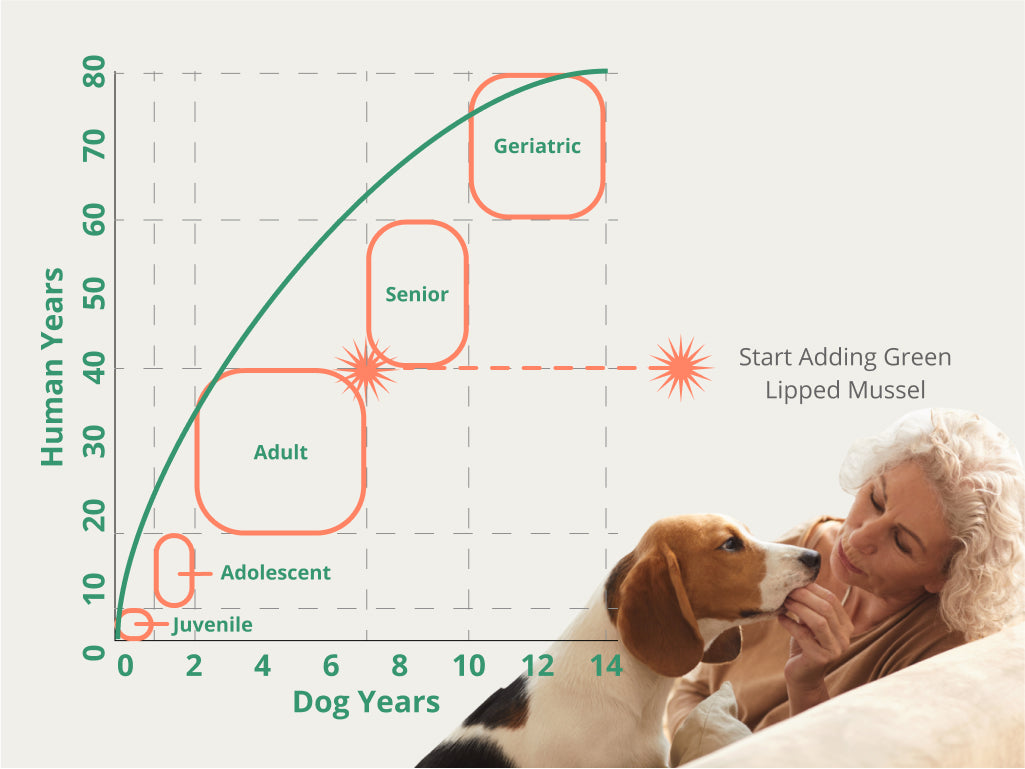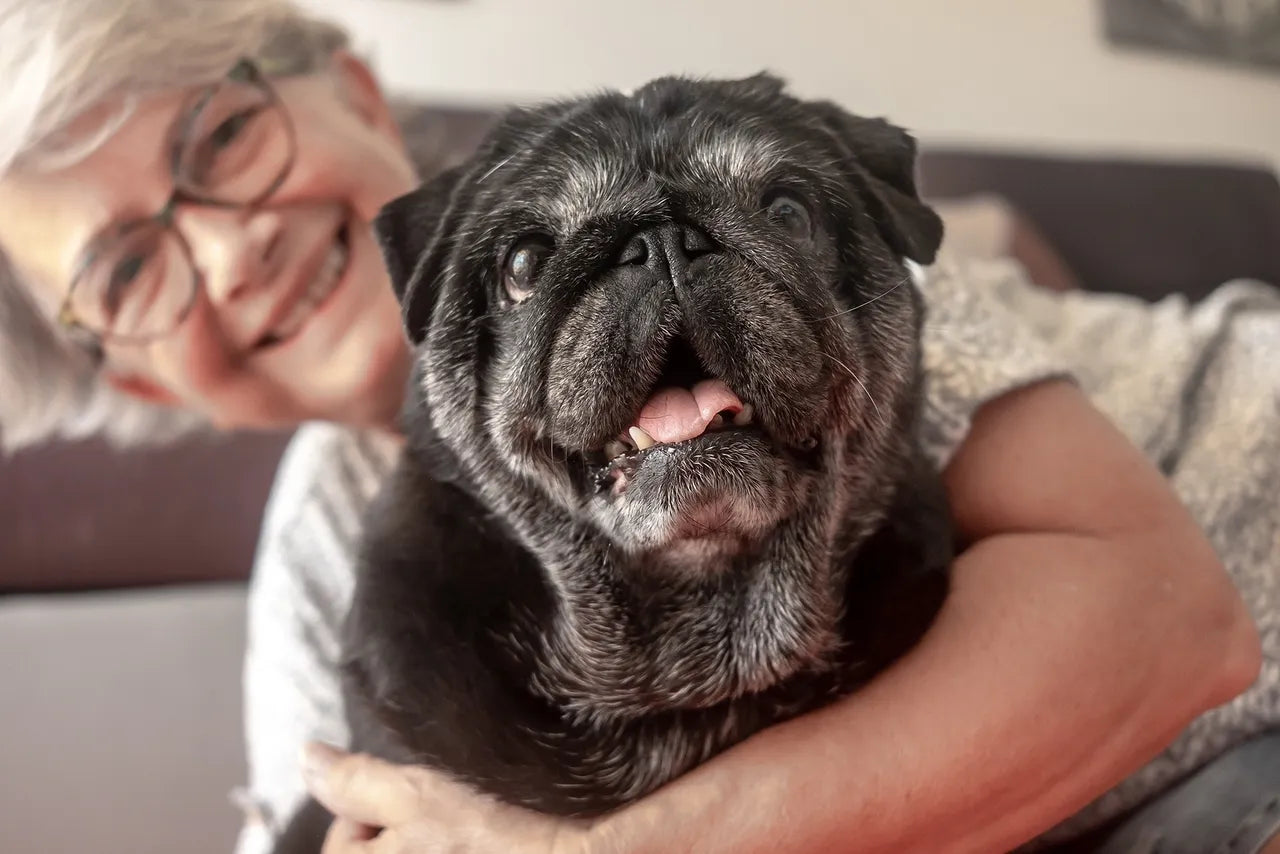Senior Dog Aging
The Senior Dog
Advanced age is not a health condition per se. However, many health conditions and diseases accompany old age. All those conditions stem from the body’s decreased efficiency.
The decreased efficiency puts the body up for a challenge which is a serious stress. Because of that stress, in addition to the obvious, physical, age-related changes, senior dogs exhibit changes in their behavioral patterns.
All in all, ageing is a complex process. It is not a disease so we cannot talk about treatment. The best way to manage old age is through providing adequate palliative care.
What happens to dogs as they age?
Senior dogs go through the same changes as senior people:
- the metabolism slows down and the body’s overall efficacy decreases
- the hairs start losing their natural pigment, and turn grey
- the joints stiffen, become less lubricated, and have lesser motion range
- the muscles become less contractible and toned
- the senses deteriorate to a point they are no longer reliable
- the mental capacity no longer has the sharpness and level of acuity as it once did.
Dogs Aging Graph
Green Lipped Mussel powder is a natural anti-inflammatory beneficial for dogs of all ages. It is essential to add too dogs diets from age 7 onwards.

What are the signs of an aging dog?
Over time, senior dogs develop Cognitive Dysfunction Syndrome (CDS). CDS is the canine equivalent of Alzheimer’s disease. Most of the signs, senior dogs exhibit can be categorized in one of the four symptom categories CDS entails.
For easy remembering, those categories are labeled with the acronym DISH. DISH stands for disorientation, interactions, sleeping, and house-training.
Disorientation – proper orientation means understanding the concepts of who, what, when and where. Senior dogs have troubles defining these concepts. Remember, the last time you had a bad dream and woke completely unaware of where you are and what day is it? Senior dogs feel that same way, and not just after waking up, but most of the time.
Interactions – normally dogs are social and playful. However, as they age they are more reluctant to engage into social behaviors. They prefer resting in peace without distractions. This is usually associated with the low-level yet chronic pain old dogs live with due to age-related issues, more often – arthritis. Just imagine, if in pain, would you be up to mingling and making contacts?
Sleeping patterns – dogs follow different sleeping cycles than humans which makes it hard to depict the sleeping pattern changes associated with old age. In general, senior dogs usually sleep during the day and then send the night pacing restlessly.
House-training – no matter how well-trained, senior dogs are prone to accidents. This is not a sign of misbehavior. Instead, it is the result of physical limitation combined with the previously mentioned general disorientation. The physical limitation part refers to the fact that muscles lose their contractility with age. The sphincter that holds the bladder is affected by that contractility loss.
Other signs of ageing in dogs include:
- Sudden emergence of new phobias and fears
- Excessive and apparently unprovoked vocalization (barking, grunting, crying, whining)
- Extreme clinginess especially toward one family member
- Accented irritability and mood swings
- Strange behaviors (staring at the wall, sitting in corners)
- Unusually pronounced destructiveness.
Human age vs. dog age
Dog age is an artificial concept we invented. We like to personify dogs and counting their age in human years is part of that personification. It is because we find it easier to pinpoint certain situations, issues, and even diseases at exact moments within a given timeframe.
Basically, this is the dog age concept we invented:
- The first year of the dog’s life equals 15 human years
- The second year of the dog’s life equals 9 human years
- After the second year, for every human year, the dog would age approximately five dog years.
Is palliative care the answer?
Palliative care is a holistic approach that focuses on improving the quality of life. It is not a treatment, but then again, ageing is not a disease.
Instead, palliative care is an addition to regular and specific treatments. Palliative care is is underrated probably because it is wrongfully associated with end of life.
Palliative care reduces the burden of symptoms and can be implemented as soon as a medical condition starts interfering with the quality of life. Dogs can live for yeas while receiving palliative care.
Palliative care manages the symptoms associated with the disease and the stress associated with the conventional treatment. Palliative care focuses on managing issues pain, anxiety, nausea, appetite loss, constipation, depression, fatigue, difficulty sleeping and shortness of breath.
Palliative care, achieves its goal – better quality of life, based on three main aspects:
- Pain medications
- Dietary strategies
- Human interactions.
The Dietary strategy as part of the palliative care approach
As dogs age, their diets should be tailored to fit and support the on-going changes. Proper nutrition is the brick and mortar of health and longevity. It can help delay the onset of certain age-related issues, decrease their intensity, or if already present, to manage their consequences.
Senior dogs have some specific dietary needs:
- Increased intake of high-quality and easily digestible proteins (to fuel the body)
- Increased fiber intake (to help with irregular bowel movements)
- Increased water intake (especially if there are co-existing kidney problems or receiving heart and blood pressure medications that promote water elimination)
- Decreased fats intake (because of the high prevalence of pancreatitis in seniors)
- Decreased phosphorus intake (particularly in cases of kidney issues)
- Supplements – fatty acids for healthy cognition, supplements that promote joint health, vitamins, minerals, and antioxidants.
Conclusion
Senior dogs can be challenging, not just because of their physical limitations, but also because of their grumpy attitude and behaviors. However, they are not to blame. Ageing, although, a normal and natural process is quite stressful.
Luckily, palliative care is a good way of managing that stress. Pain management, tailored diets and a loving support system are the best way you can help your ageing dog. Senior dogs deserve all the love they can get.


